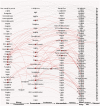Life cycle assessment of metals: a scientific synthesis
- PMID: 24999810
- PMCID: PMC4085040
- DOI: 10.1371/journal.pone.0101298
Life cycle assessment of metals: a scientific synthesis
Abstract
We have assembled extensive information on the cradle-to-gate environmental burdens of 63 metals in their major use forms, and illustrated the interconnectedness of metal production systems. Related cumulative energy use, global warming potential, human health implications and ecosystem damage are estimated by metal life cycle stage (i.e., mining, purification, and refining). For some elements, these are the first life cycle estimates of environmental impacts reported in the literature. We show that, if compared on a per kilogram basis, the platinum group metals and gold display the highest environmental burdens, while many of the major industrial metals (e.g., iron, manganese, titanium) are found at the lower end of the environmental impacts scale. If compared on the basis of their global annual production in 2008, iron and aluminum display the largest impacts, and thallium and tellurium the lowest. With the exception of a few metals, environmental impacts of the majority of elements are dominated by the purification and refining stages in which metals are transformed from a concentrate into their metallic form. Out of the 63 metals investigated, 42 metals are obtained as co-products in multi output processes. We test the sensitivity of varying allocation rationales, in which the environmental burden are allocated to the various metal and mineral products, on the overall results. Monte-Carlo simulation is applied to further investigate the stability of our results. This analysis is the most comprehensive life cycle comparison of metals to date and allows for the first time a complete bottom-up estimate of life cycle impacts of the metals and mining sector globally. We estimate global direct and indirect greenhouse gas emissions in 2008 at 3.4 Gt CO2-eq per year and primary energy use at 49 EJ per year (9.5% of global use), and report the shares for all metals to both impact categories.
Conflict of interest statement
Figures







References
-
- Greenfield A, Graedel TE (2013) The omnivorous diet of modern technology. Resour Conserv Recycl 74: : 1–7. Available: http://www.sciencedirect.com/science/article/pii/S0921344913000396. Accessed 29 October 2013.
-
- Graedel TE, Erdmann L (2012) Will metal scarcity impede routine industrial use? MRS Bull 37: 325–331 10.1557/mrs.2012.34 - DOI
-
- Van der Voet E, Salminen R, Eckelman M, Mudd G, Norgate T, et al... (2013) Environmental Risks and Challenges of Anthropogenic Metals Flows and Cycles. A Report of the Working Group on the Global Metal Flows to the International Resource Panel. United Nations Environment Programme (UNEP).
-
- Kleijn R, van der Voet E, Kramer GJ, van Oers L, van der Giesen C (2011) Metal requirements of low-carbon power generation. Energy 36: : 5640–5648. Available: http://www.sciencedirect.com/science/article/pii/S0360544211004518. Accessed 24 July 2013.
-
- Elshkaki A, Graedel TE (2013) Dynamic analysis of the global metals flows and stocks in electricity generation technologies. J Clean Prod. Available: http://www.sciencedirect.com/science/article/pii/S0959652613004575. Accessed 24 July 2013.
Publication types
MeSH terms
Substances
LinkOut - more resources
Full Text Sources
Other Literature Sources
Miscellaneous

